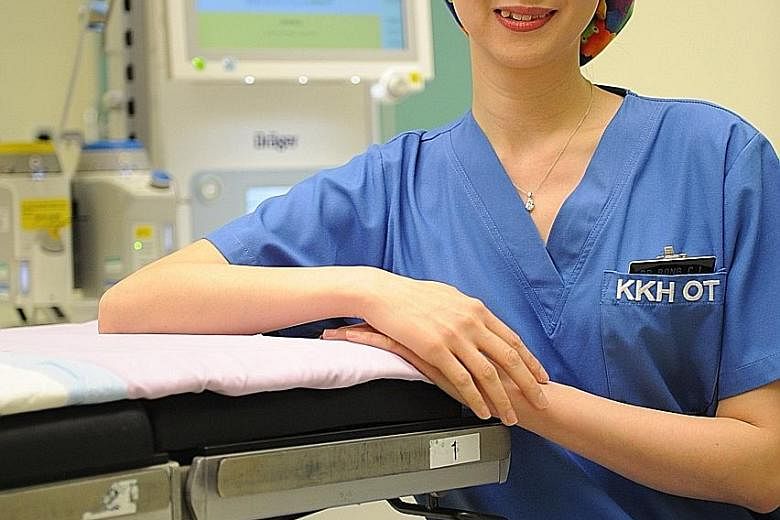Q I sub-specialise in paediatric anaesthesia because…
A I can provide anaesthesia care and pain relief to children of all ages, ensuring that they remain safely asleep or sedated throughout the duration of surgical or imaging procedures that require them to remain still.
Q Paediatric anaesthesia is different from adult anaesthesia because...
A Each age group presents unique challenges in terms of their anatomy, physiology and the way their bodies respond to and handle drugs (pharmacology).
Airways in young children are different from those in adults, so the equipment used is different. Their veins are tinier, so it is harder to perform medical procedures such as inserting intravenous drips.
Children are physically smaller, and have higher metabolic rates and lower oxygen and energy reserves.
-
Bio Box
-
BONG CHOON LOOI
Age: 42
Occupation: Senior consultant at the department of paediatric anaesthesia at KK Women's and Children's Hospital (KKH).
Dr Bong graduated from the University of Edinburgh and completed her basic anaesthesia training in Edinburgh, Scotland.
She returned to Singapore for her advanced speciality training in Singapore General Hospital before joining KKH to specialise in paediatric anaesthesia in 2005.
She subsequently obtained her paediatric anaesthesiology fellowship from the Children's Hospital Boston in the United States, and was an instructor in anaesthesia at Children's Hospital Boston and assistant professor at Harvard Medical School before returning to Singapore in 2008.
Her research interests include the effects of general anaesthesia on neurocognitive development in children, and the stress response of trainees during medical simulation.
Dr Bong is married to a 45-year-old cardiologist. They have two daughters, aged 12 and eight.
Joan Chew
If there is an acute problem such as an airway obstruction or bleeding, their bodies are less able to correct the problem when compared with adults, so the medical team needs to act a lot more quickly to prevent harm.
We usually put children to sleep using a mask through which anaesthetic gas is administered, instead of using an anaesthetic injection, as we usually do for adults.
Q The effect of anaesthesia on children is fascinating because…
A The drugs work to make parts of the brain less active, to achieve a reversible state of unconsciousness, but no one is really quite sure how exactly this state of unconsciousness is achieved.
A young child's brain develops rapidly and is vulnerable to the effects of anaesthesia and sedatives.
General anaesthesia is very safe for children in terms of short-term effects on the heart and vital organs, leading to a lowered breathing rate and a slower heart rate.
Studies are under way to determine long-term effects of early exposure to anaesthesia in humans.
Q One little-known fact about putting children to sleep is...
A We have fun before that. We blow bubbles and use things like tablets to entertain them and put them at ease before we put them to sleep.
When they wake up, they get a printed certificate telling them that they performed bravely for the surgery.
Q What I do is like being...
A A pilot who works in a cockpit. I work in an operating theatre with high-tech machines and a medical team that includes surgeons and nurses.
My aim is to take care of the patient from take-off (going to sleep) to landing (waking up) and beyond, making sure he is safe, sedated and comfortable throughout, while facilitating the operation.
As with many segments of the aviation industry, anaesthesia is a high-risk speciality and there should be zero mistakes.
Q I come across all types of cases...
A From newborns needing major heart and bowel operations to toddlers with airway emergencies in the middle of the night and older children with acute appendicitis.
There are also routine hernia operations, circumcisions and tonsillectomies, which are more common.
The smallest child I ever anaesthetised was a premature baby who weighed only 400g and needed a major operation to resect the intestines. We took extreme caution and the surgery was a success.
Q Most of my patients are too young to...
A Be at fault. On very rare occasions, I see a developmentally normal child who is rude and physically aggressive to his or her own parents and/or the hospital staff.
I respond by being firm and the child usually cooperates after that.
Q It breaks my heart when...
A I see a child who is battling cancer come in repeatedly for operations. To see such children and the strength and dignity shown by their families in the face of pain and adversity is a humbling experience.
Q I wouldn't trade places for the world because...
A I love my job. I get to look after the youngest and most vulnerable group of patients, and to protect them from pain and other potential dangers related to surgery.
They might not remember me, but I like to think that I have helped in their long-term well-being.
I work in a great department where everyone is helpful and supportive - it is like working with one's own family.
Q My best tip...
A Treat others as you would want your loved one or yourself to be treated. Medical professionals should put themselves in the patient's shoes or see the patient as a loved one, and this should determine the way they treat patients who are under their care.

